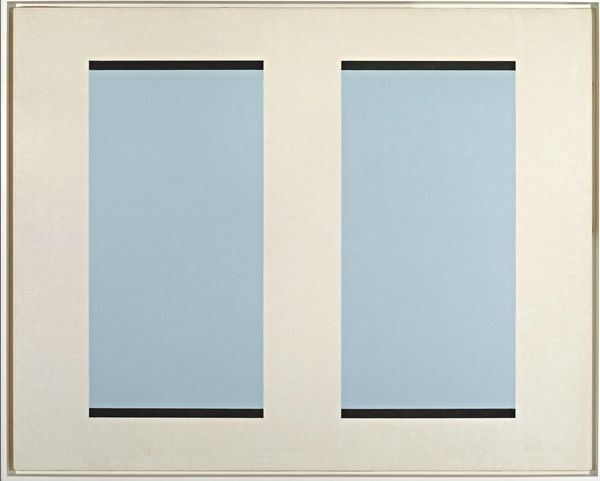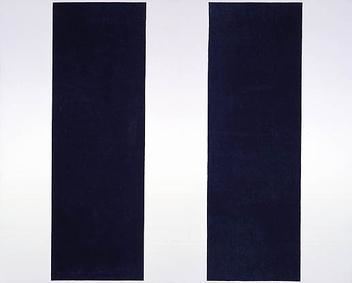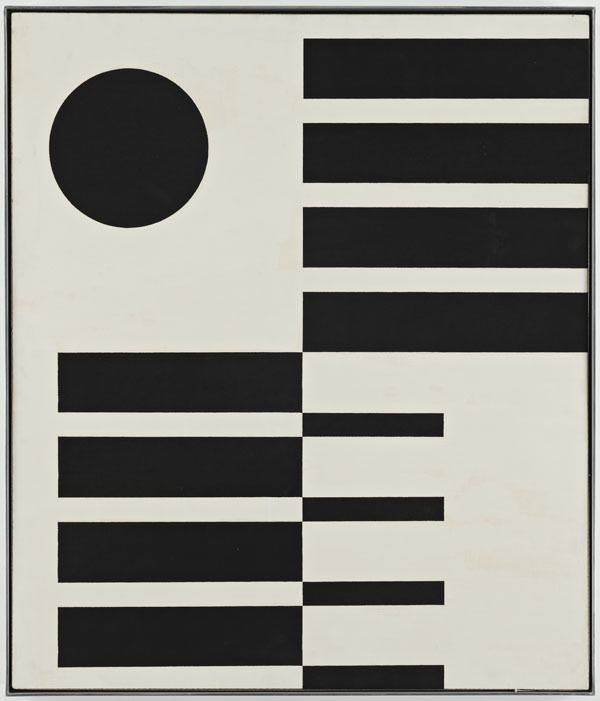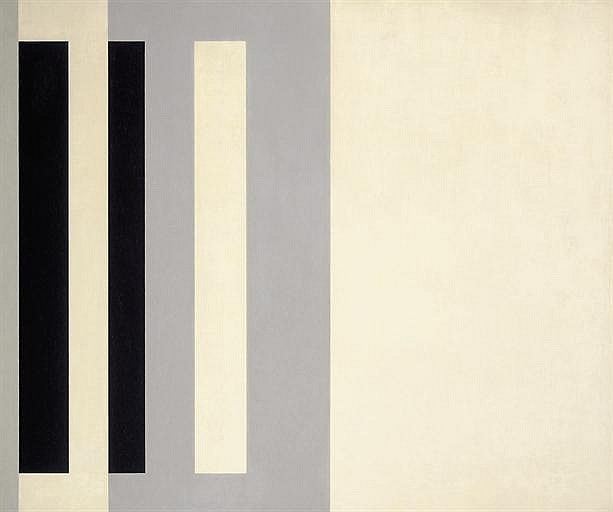Nationality American Name John McLaughlin | Role Artist | |
 | ||
Full Name John Dwyer McLaughlin Education University of Hawaii at Manoa Artwork Number 23, #10, Untitled, Number 2, #3-1970, JMD-3 Periods Hard-edge painting, Minimalism | ||
Seing john mclaughlin
John Dwyer McLaughlin (May 21, 1898 – March 22, 1976) was a highly pivotal and significant American abstract painter. Based primarily in California, he was a pioneer in minimalism and hard-edge painting. Long considered in California as one of the most significant artists of the postwar, McLaughlin painted a focused body of geometric works that are completely devoid of any connection to everyday experience and objects, inspired by the Japanese notion of the void. He aimed to create paintings devoid of any object hood including but not limited to a gestures, representations, figuration, and so on. This led him to the rectangle. Leveraging a technique of layering rectangular bars on adjacent planes, McLaughlin creates works that provoke introspection and, consequently, a greater understanding of one’s relationship to nature. Christopher Knight affirms "McLaughlin is among the most profound avant-garde painters to work in the United States in the aftermath of the cataclysm that was World War II. He’s also Southern California’s first momentous postwar artist. Born in the closing years of the 19th century, he laid the foundation for the environmentally scaled wonders of 1960s Light and Space art, which ranks as Los Angeles’ most original contribution to high culture at the end of the 20th century...McLaughlin began to paint just as its gestural extravagances and emotionally fraught chromatics began to coalesce into the New York School. In the wake of the Holocaust and Hiroshima, those artists stared straight into the void...[McLaughlin's] void is not an abyss of social and spiritual terror in which interior narratives of worldly experience can be told, as it was for Jackson Pollock or Mark Rothko. Instead, his is the negative space that allows consciousness to blossom and manifest itself. Their art is about inviting us into their deep perception, while his is about inviting us into our own. McLaughlin’s void is ma, the poetic space and interval between things that animate Japanese art".
Contents

John mclaughlin lacma
Life

John McLaughlin was born in Sharon, Massachusetts. His father was a Massachusetts Superior Court judge and he had six siblings. His parents instilled in him an interest in art, most specifically Asian art.

McLaughlin served in both World Wars. His service in the United States Navy during World War I spanned from 1917 to 1921.

In 1928 he married Florence Emerson, a grandniece of Ralph Waldo Emerson. In 1935 they moved to Japan, where McLaughlin studied the art and language. When they returned to Boston in 1938, they opened The Tokaido, Inc., an art gallery which specialized in Japanese prints and other Asian items.

After studying Japanese at the University of Hawaii in Honolulu, he served the United States Marine Corps in World War II as a translator. Later in the war, he worked in U. S. Army Intelligence as a translator in Japan, India, China and Burma. In 1945 he was awarded the Bronze Star for meritorious service.
Painting career
McLaughlin had begun painting during the 1930s, relatively late in life. He was self-taught, without receiving formal artistic training. His fondness for Asian art and his travels in that part of the world influenced his artistic style.
He settled in Dana Point, California in 1946 and began painting full-time.
A few of his earliest paintings were still lifes and landscapes, but the remainder of his pieces were abstracts. During this time period, he was one of just a few American artists creating abstracts. McLaughlin's work is characterized by a simplicity expressed as precise geometric forms, usually rectangles. His experiences in Asia were very important in developing his style. Zen masters taught that spaces between objects (the "marvelous void") could be more important than the objects themselves in facilitating meditation. The work of Kazimir Malevich and Piet Mondrian also strongly influenced McLaughlin. He wrote: "With respect to my direct influences I must stress my interest in 15th and 16th century Japanese painters. I have found comfort in some aspects of thought expressed by Malevitch, and I am indebted to Mondrian because his painting strongly indicated that the natural extension of Neo-Plasticism is the totally abstract."
From 1952 onward, he ceased using curves in his work. Paintings from his later period show increasing simplification of form and color palette.
He described his artistic philosophy: "My purpose is to achieve the totally abstract. I want to communicate only to the extent that the painting will serve to induce or intensify the viewer's natural desire for contemplation without benefit of a guiding principle. I must therefore free the viewer from the demands or special qualities imposed by the particular by omitting the image (object). This I manage by the use of neutral forms."
McLaughlin's first solo exhibition was in 1952 at the Felix Landau Gallery in Los Angeles. He also showed with André Emmerich in New York and Zurich. His many other museum solo exhibition venues included the Pasadena Art Museum, Corcoran Gallery, La Jolla Museum of Contemporary Art, and Whitney Museum of American Art. His work was also included in numerous group exhibitions, including the landmark "Four Abstract Classicists" exhibit at the Los Angeles County Museum of Art. This show, also featuring the work of Karl Benjamin, Lorser Feitelson, and Frederick Hammersley, was organized by Jules Langsner who, along with Peter Selz, coined the term "hard-edge painting" to describe the work of these four abstract artists. Langsner wrote: "Deliberately neutral in character, John McLaughlin's forms might be described as anonymous. Essentially color serves him as a means of defining and regulating a form's relative importance in the composition. Each painting represents the outcome of a process of refinement."
A touring exhibition "Birth of the Cool: California Art, Design and Culture at Midcentury" featured the abstract classicists. New York Times art critic Ken Johnson wrote in his 2008 review of the show at the Addison Gallery of American Art: "Mr. McLaughlin's grid-based paintings exude a greater formal austerity [than Benjamin's]. They are composed of smooth, flat rectangles of black, white, off-white and gray with blocks of color strategically inserted here and there. Inspired by Asian art and Zen Buddhism, they have a monastic air about them, but they are suave and materially sensuous too."
Life magazine published a special issue in 1962 on the state of California. It highlighted five renowned artists, including John McLaughlin. (The others were Stanton Macdonald-Wright, Robert Irwin, Billy Al Bengston, and Roger Kuntz.)
McLaughlin died on March 22, 1976, in Dana Point at the age of 77.
In 1963, the Pasadena Art Museum (now the Norton Simon Museum) exhibited McLaughlin's first major museum retrospective curated by the legendary Walter Hopps. In 1968, the Corcoran Gallery of Art exhibited McLaughlin's second major museum retrospective curated by James Hartithas. In 1975, the Laguna Art Museum held McLaughlin's second museum retrospective.
In November 2016, McLaughlin was subject to a long overdue third major museum retrospective at LACMA. A review of the show by art critic Christopher Knight affirms "McLaughlin occupies the top tier of 20th century American art".
Legacy
McLaughlin’s paintings contribute to the Western avant-garde tradition of abstraction, particularly in regards to Kazimir Malevich and Piet Mondrian. As noted earlier, the term 'hard-edge' was originally coined to describe his work and went on to describe the works of Ellsworth Kelly and other reductive geometric works but perhaps, his most similar contemporary was Ad Reinhardt. What sets McLaughlin's work apart from other hard-edge painters as well as other 'abstractionists' from the west is its indebtedness to Japanese interiors as well as the Japanese sense and notion of ma.
The reductive geometric character along with the influence of Japanese ma of McLaughlin's work serves as a bridge from the canvas of hard-edge painting and Abstract Expressionism to environmental displays of Light and Space as McLaughlin is widely acknowledged for laying the foundation for 1960s Light and Space art, Los Angeles’ most original contribution to high culture at the end of the 20th century. Artist associated with the movement include James Turrell, John McCracken, Larry Bell, Robert Irwin, Craig Kauffman, Peter Alexander, Bruce Nauman, Doug Wheeler. The wake of his influence extends to Ed Ruscha, Robert Ryman, Ed Moses, Mark Grotjahn, Roy McMakin, Marcia Hafif, Tony Berlant, Tony DeLap, James Hayward and others.
Collections
A few of the major collections containing McLaughlin's work:
